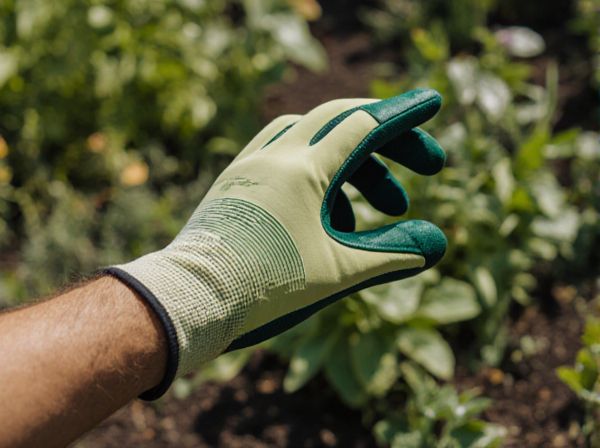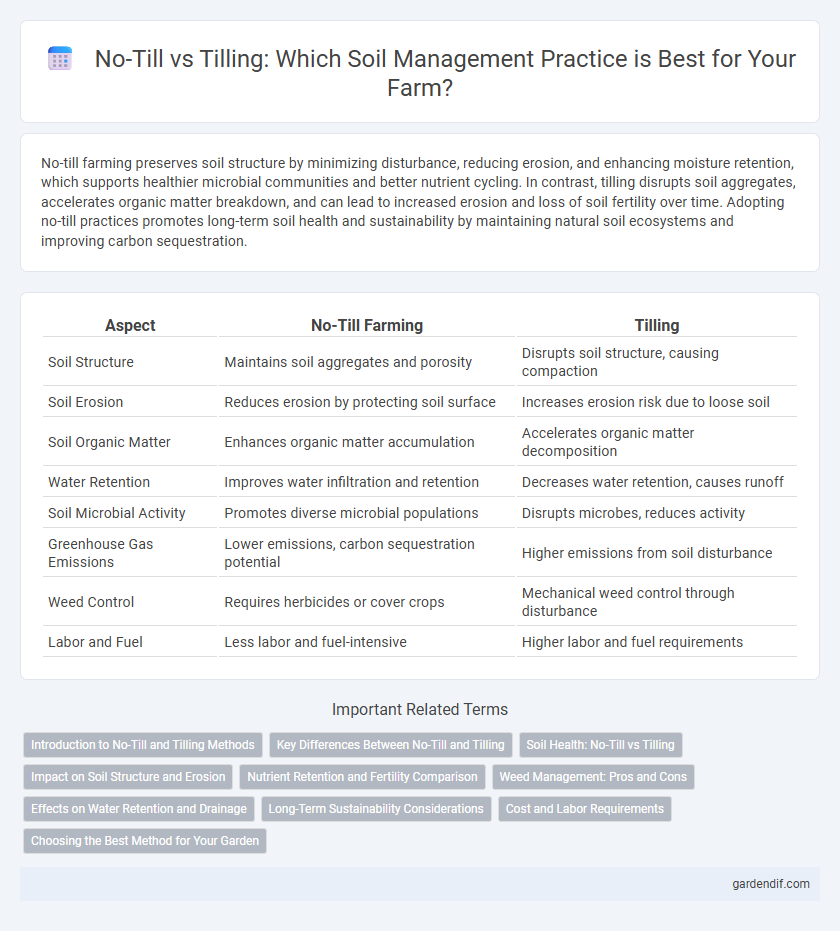
No-Till vs Tilling Illustration
No-till farming preserves soil structure by minimizing disturbance, reducing erosion, and enhancing moisture retention, which supports healthier microbial communities and better nutrient cycling. In contrast, tilling disrupts soil aggregates, accelerates organic matter breakdown, and can lead to increased erosion and loss of soil fertility over time. Adopting no-till practices promotes long-term soil health and sustainability by maintaining natural soil ecosystems and improving carbon sequestration.
Table of Comparison
| Aspect | No-Till Farming | Tilling |
|---|---|---|
| Soil Structure | Maintains soil aggregates and porosity | Disrupts soil structure, causing compaction |
| Soil Erosion | Reduces erosion by protecting soil surface | Increases erosion risk due to loose soil |
| Soil Organic Matter | Enhances organic matter accumulation | Accelerates organic matter decomposition |
| Water Retention | Improves water infiltration and retention | Decreases water retention, causes runoff |
| Soil Microbial Activity | Promotes diverse microbial populations | Disrupts microbes, reduces activity |
| Greenhouse Gas Emissions | Lower emissions, carbon sequestration potential | Higher emissions from soil disturbance |
| Weed Control | Requires herbicides or cover crops | Mechanical weed control through disturbance |
| Labor and Fuel | Less labor and fuel-intensive | Higher labor and fuel requirements |
Introduction to No-Till and Tilling Methods
No-till farming conserves soil structure by minimizing disturbance, preserving organic matter and enhancing microbial activity, which promotes sustainable soil health. Tilling disrupts the soil surface, accelerating nutrient mineralization but increasing erosion risk and moisture loss. Understanding these contrasting methods highlights the balance between immediate weed control and long-term soil conservation.
Key Differences Between No-Till and Tilling
No-till farming preserves soil structure by minimizing disturbance, promoting microbial activity and reducing erosion, while tilling breaks up soil to prepare seedbeds but can lead to increased erosion and loss of organic matter. No-till enhances water retention and carbon sequestration, making it more sustainable for long-term soil health compared to conventional tilling practices. Crop residue remains on the surface in no-till, providing natural mulch that suppresses weeds and conserves moisture, unlike tilling which buries residues and exposes soil to environmental stress.
Soil Health: No-Till vs Tilling
No-till farming preserves soil structure and enhances microbial activity by minimizing disturbance, leading to improved soil health and higher organic matter content. Tilling disrupts soil aggregates, accelerates erosion, and reduces beneficial organisms, negatively impacting nutrient cycling. Studies show no-till practices increase water retention and carbon sequestration, which supports sustainable agriculture and long-term soil fertility.
Impact on Soil Structure and Erosion
No-till farming preserves soil structure by maintaining organic matter and minimizing disturbance, which enhances water infiltration and reduces compaction. In contrast, tilling disrupts soil aggregates, leading to increased erosion and loss of topsoil nutrients. Studies show no-till practices significantly decrease surface runoff and soil erosion rates compared to conventional tilling methods.
Nutrient Retention and Fertility Comparison
No-till farming enhances nutrient retention by preserving soil structure and organic matter, which supports microbial activity and reduces nutrient leaching. In contrast, tilling disrupts soil aggregates and can accelerate nutrient loss through erosion and oxidation, leading to decreased fertility over time. Research shows no-till systems maintain higher levels of nitrogen, phosphorus, and potassium, crucial for sustainable crop productivity.
Weed Management: Pros and Cons
No-till farming reduces soil disturbance, which helps preserve soil structure and microbial life, but it may lead to increased weed pressure due to less mechanical disruption of weed seeds. Tilling effectively controls weeds by physically uprooting them and burying weed seeds, yet it can cause soil erosion, reduce moisture retention, and disrupt beneficial soil organisms. Integrating targeted herbicide use or cover crops in no-till systems can enhance weed management while maintaining soil health benefits.
Effects on Water Retention and Drainage
No-till farming enhances soil structure by maintaining organic matter and pore spaces, significantly improving water retention compared to tilling, which disrupts soil aggregates and reduces moisture-holding capacity. Tilling increases surface evaporation and can lead to faster drainage, often causing nutrient leaching and soil erosion. Improved water infiltration and sustained soil moisture in no-till systems support healthier crop growth and greater resilience during drought conditions.
Long-Term Sustainability Considerations
No-till farming enhances long-term soil health by preserving soil structure, increasing organic matter, and reducing erosion compared to conventional tilling methods, which can degrade soil quality and disrupt microbial communities. Maintaining higher levels of soil carbon and moisture through no-till practices supports sustainable crop production and resilience against climate variability. Long-term sustainability also depends on integrated management strategies that balance no-till benefits with potential challenges like weed control and nutrient management.
Cost and Labor Requirements
No-till farming significantly reduces labor costs and time by eliminating the need for plowing, which lowers fuel consumption and machinery wear. In contrast, conventional tilling demands higher labor input and recurring expenses for equipment operation and maintenance. The cost-efficiency of no-till practices aligns with sustainable soil management and improved farm profitability.
Choosing the Best Method for Your Garden
No-till gardening preserves soil structure, enhances microbial activity, and reduces erosion, making it ideal for maintaining long-term soil health. Tilling aerates the soil and incorporates organic matter quickly, which can boost early plant growth but may disrupt beneficial organisms and increase erosion risk. Assess your garden's soil type, erosion susceptibility, and crop needs to determine whether the sustainable benefits of no-till or the immediate soil conditioning of tilling aligns best with your cultivation goals.
No-Till vs Tilling Infographic

 gardendif.com
gardendif.com